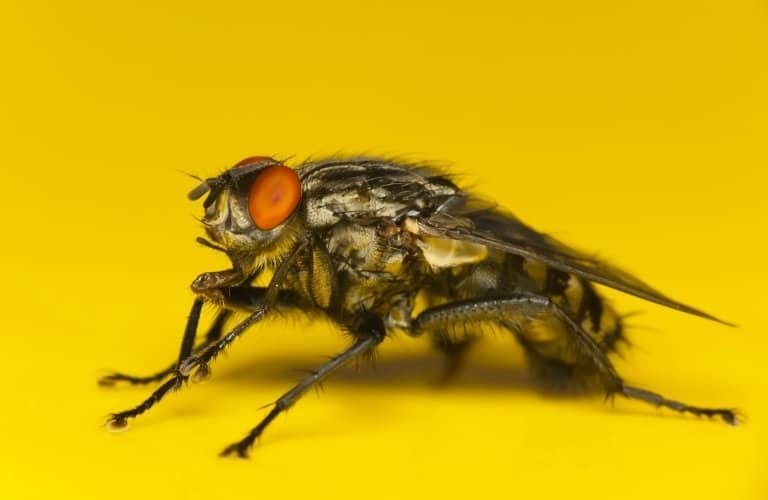Flies aren’t dangerous, but they certainly are annoying. These bothersome pests buzz irritatingly around your head, land on your food, and can make life just plain miserable.
If you are being plagued by these troublesome insects, rest assured, you’re not alone. You could learn to live with them, or you could take a few simple steps to banish them from your home and yard.
How do you get rid of flies? To get rid of flies, you can use natural methods like planting herbs and flowers that repel them, use sticky flypaper to catch them, or use light traps to zap them. You can also use pesticides, such as granules, dust, fogger, and residual insecticide concentrate.
Identification
Houseflies are the most common fly you’ll find in or around your house.
They’re usually about 6 or 7 millimeters long (about ¼ inch) with big red eyes and one pair of wings. They’re gray or black and have stripes on their body, which is covered with tiny little hairs.
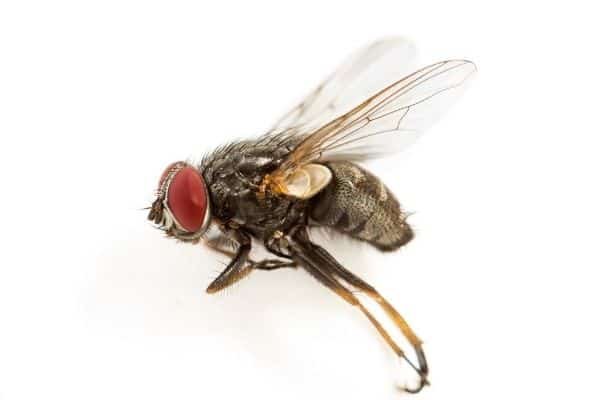
Other Types of Flies
The common housefly isn’t the only fly that might bug you to death. There are different types of flies that are attracted to different areas of the home.
Fruit flies are typically found in the kitchen around bananas and other fruits, while drain flies are typically found in bathrooms.
| Gnat |  |
Gnat is a general term referring to insects that typically fly around at dusk in swarms. They feed on plants and are often found around houseplants. |
| Blow Fly |  |
The blow fly is metallic bluish-green and black. They’re hairy like houseflies, have one pair of wings, and are attracted to pungent smells like rotten meat. |
| Fruit Fly | 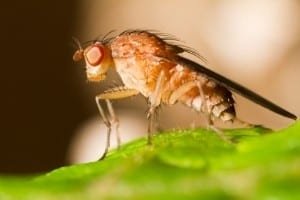 |
The fruit fly hangs around over-ripe and rotting fruit. They’re usually yellow, brown, or black, with red eyes and are much smaller than houseflies, just 2 – 4 millimeters long. Learn to identify them here. |
| Phorid Fly | 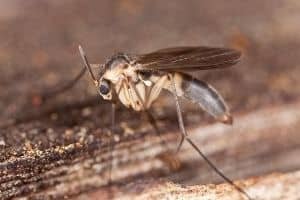 |
Phorid flies, or scuttle flies, can be black, brown, yellow, orange, gray, or white. They’re easily identifiable because they often run across surfaces instead of flying. |
| Drain Fly | 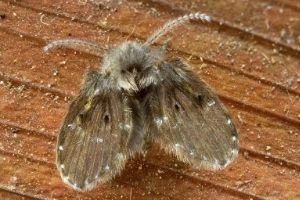 |
Drain flies like to live in wet environments and can often be found in bathroom drains. They’re usually 4 – 5 millimeters long, are nocturnal, and can actually unclog drains. |
| Mosquito |  |
Mosquitoes aren’t usually considered flies, but they’re in the order Diptera, just like flies. They’re long-legged, blood-sucking insects typically found around standing water. |
Removal Methods
|
Method |
Cost |
Natural |
Odor-Free |
|
DIY traps |
$10 or less |
✅ |
✅ |
|
Eucalyptus oil |
$7 – $25 |
✅ |
Low |
|
Flypaper |
Approx. $10 |
✅ |
✅ |
|
Fogger |
Approx. $10 |
✅ |
|
|
Granule fly bait |
Approx. $15 |
✅ |
|
|
Insecticide dust |
Approx. $20 |
✅ |
|
|
Light traps |
$25 or more |
✅ |
|
|
Plants that act as repellants |
Varies; Approx. $20 or more |
✅ |
Low |
|
Pyrethrin insecticide aerosols |
Approx. $30 |
✅ |
Low |
The Best Way to Eliminate Flies
The most effective way to get rid of an infestation of flies quickly is to use a light trap (like this one on Amazon). Depending on the type you use, they can be so quiet and dim that they almost go unnoticed. The light attracts the flies, and they are either zapped with high voltage or sucked in with a vacuum.
The zapping kind of trap will kill flies instantly, but you’ll have to wait for the insects to die with the vacuum type of trap.
Most traps can be used indoors and outdoors. You can place them on the table while you’re eating or by the back door to prevent them from going inside.
The downside of this method is that it’s only effective against adult flies. Larvae need to be killed before they turn into adult flies.
Pesticides are a quick and easy solution, but they have several health risks associated with them, which will be discussed further later in this article.
Basic Guidelines
Prevention is the best way to get rid of flies. Flies only infiltrate your home and yard when ideal breeding grounds are present.
Dirty garbage cans, warm weather, rotting food, tall grass, and animal feces are all attractive to flies, and standing water will attract mosquitoes.
If these conditions don’t exist, flies won’t be much of a problem.
Remove the Breeding Ground
- Don’t Have Dirty Garbage
- If garbage cans have pieces of food or liquids sitting at the bottom underneath the bag, spray them out with a hose and leave them upside down to dry out completely.
- Routinely check for dropped pieces of food or spilled beverages since this is the prime place for flies to lay eggs.
- Pick Up After Animals
- Animal feces are another ideal spot for flies to lay eggs. Chicken and pig manure are especially attractive to flies, so if you have backyard chickens, keep them away from your back door.
- Fido’s feces needs to be picked up too because flies aren’t picky.
- Keep a Lid on Food
- Food shouldn’t be left out on the kitchen counter. Make sure everything is kept in an airtight container. If you’re sitting on your patio, make sure all food is covered.
Seal Up the Entry Points
You might be surprised by the ingenuity and determination of a fly that is attempting to gain entrance to your house.
This article can help you pinpoint all of the possible entry points in your home, but doors and windows are the most common.
- Put Screens on Doors and Windows: Don’t open a window for fresh air unless you have a screen to prevent flies from coming in.
- Don’t Leave Doors Open: People come in and out during a cookout, but don’t leave the door open for too long. Promptly shut it after stepping through.
- Make Sure Windows and Doors Are Sealed Shut: Cracks in or around the door and windows are entry points for flies. Repair broken glass or caulk holes and gaps to prevent flies from coming through.
Keep Flies at Bay
- Plant Aromatic Herbs and Flowers
- Basil, bay leaves, catnip, lavender, and marigold keep flies away because of the smell. Plant them in pots or beds near windows and doors or wherever the flies are getting inside.
- (A more complete list of smells that repel flies can be found here.)
- These aromatic plants don’t usually bother humans and can even be consumed or used as a seasoning on dishes.
- Keep in mind that the catnip might introduce a different kind of pest at your back door.
- Don’t Let Water Pool Up
- Birdbaths, fountains, and puddles left after the rain are perfect breeding grounds for mosquitoes, and stagnant water will attract flies.
- If you have a water feature in your yard, keep it away from doors and windows. Use a broom or leaf blower to remove water puddles that are left behind after the rain.
- Place Traps Around Doors
- It isn’t always the best idea to place traps near entry points, but if these pests keep finding their way inside, it might be necessary.
- Placing light traps, flypaper, or sugar water traps in close proximity to entry points can be a clever way to distract flies from coming inside.
Natural Solutions to Get Rid of Flies
It’s always wise to try natural solutions before resorting to pesticides. Pesticides are known to be linked to several health conditions, including cancer and ADHD.
Try using natural methods first and allowing them some time to work. These solutions can take some time to take effect, especially if you’re planting herbs and flowers.
Indoor Infestations
Indoor infestations are arguably the most annoying kind. You’re likely to find flies in your bathroom, around garbage cans, and in the kitchen around food.
Because flies can live for quite some time (find out exactly how long here), you’ll definitely want to eradicate the problem before they drive you crazy.
Houseplants can get gnat infestations which will cause annoyances in the living room or bedroom.
Fortunately, there are natural solutions you can try to get rid of them that won’t cause any harm to you or your home.
DIY Traps
Do-it-yourself traps are inexpensive ways to trap flies in your home. You can make them in just a few minutes with household supplies, so you might not need to spend any money.
These traps can be effective for single flies or if you have multiple flies flying around. If you have an infestation that’s getting out of hand, these might not be effective enough.
Supplies you’ll need:
- Water.
- Apple cider vinegar.
- Sugar.
- Dish soap.
- Tall glass/containers.
- Plastic wrap.
- Rubber band.
You can make several different traps with these supplies. One trap only requires a few of the items on the list, so you can make whichever kind you have the supplies for.
To make the traps:
- Find a container. A tall glass works well because it’s harder for the flies to get out of, but you can use any type of container or bowl.
- Create the lure. The lure is a mixture that will attract the fly into the trap and prevent them from getting out. The best lures to make include:
- Equal parts dish soap and apple cider vinegar (optional: add sugar).
- Equal parts water and sugar.
- Make the entrance. Place plastic wrap over the top of the container and secure it with a rubber band. Poke some small holes with a sharp object, just big enough for the flies to enter, but small enough to make it difficult for them to get out.
Set the traps in rooms where you frequently find flies and give them some time to work. Flies need time to find them and get inside.
Eucalyptus Oil
Eucalyptus oil is a great way to deter flies. It won’t kill them or trap them, but it can keep them away because they don’t like the smell.
Take strips of paper and coat them in oil. Hang them near windows and doors or wherever you frequently find flies.
You can also apply small amounts to your skin to deter them while you’re outside.
Artizen Eucalyptus Essential Oil is a great oil to use. It’s 100% pure eucalyptus oil. Some brands water down their oil with other oils to reduce production costs. The Artizen brand doesn’t do that.
Since it’s pure eucalyptus oil, it’s especially potent and will be more effective when it comes to keeping flies away.
If you are not a fan of eucalyptus or are allergic, don’t worry as there are plenty of other smells that flies detest. Click here to find an alternative to eucalyptus.
Fly Paper
Fly paper is another natural trap to get rid of flies. The paper is usually a bright yellow that attracts pests and is covered in a sticky glue.
Once the flies land on the paper, they get stuck and they stay there. Eventually, they’ll die on the paper.
BestTrap Sticky Traps are a great option. They can be used indoors or outdoors and won’t be affected by rain or sun exposure.
You can place them near the back door to attract the flies that keep coming inside, in the kitchen, or near houseplants that are infested with gnats.
This pack comes with 20 sheets and will last until it’s covered with flies or dirt.
Outdoor Infestations
Outdoor infestations are annoying if you like to spend time outdoors, and they can easily become indoor infestations if enough pests come inside.
There are a couple of natural outdoor solutions you can use to trap and deter pests. Pesticides can harm beneficial insects and plants, so it’s better to try natural solutions first.
Light Traps
There are a variety of light traps on the market to suit your needs. These traps are effective for flies, moths, mosquitoes, and whatever other flying pests are bugging you.
There are two types of light traps: the kind that zaps the bugs and the kind that traps the bugs.
The zapping kind uses high voltage to kill the insect upon contact.
The trapping kind uses the light to attract the bugs and will have a vacuum-like mechanism that will suck them into the trap. They’ll eventually die while they’re trapped inside.
The SHCAPENM Bug Zapper is recommended because it’s small, quiet, and easy to clean.
The light is soft for human eyes, so you can use it as a nightlight if you need to, and it doesn’t make a loud buzzing noise like many other brands do.
To clean it, you simply remove the tray at the bottom, dump out the pests, rinse with water, and return it to the machine.
This trap has a barrier around it to prevent people and pets from touching the high voltage. It’s perfectly safe to keep indoors or outdoors.
Don’t miss out on our complete guide to fly traps for buying tips and recommendations.
Plants
Plants that repel flies are a beautiful way to keep them from coming indoors. The following plants repel flies:
- Basil.
- Bay leaves.
- Catnip.
- Lavender.
- Marigold.
Plant them near doors and windows or around your patio table. You can also place them in a window sill that receives plenty of light throughout the day.
This method takes time since plants need to grow and form their leaves and flowers to become effective.
Keep in mind that plants attract pollinators and other beneficial insects, so if you don’t want any kind of bug, this might not be the solution for you.
Be sure to read this to learn of other safe, natural fly repellents.
Pesticide Solutions to Get Rid of Flies
Pesticides are dangerous to humans and pets. They’re poisons that kill bugs, and they can definitely harm other living things, too.
Acute effects caused by ingesting or touching them can be vomiting, coughing, loss of consciousness, and in severe cases, seizures and death.
Long-term effects caused by constant exposure to small amounts can lead to Parkinson’s, ADHD, cancer, and asthma. They can also cause congenital disabilities if the pregnant mother is exposed to them.
Why use pesticides if they’re so dangerous? Sometimes you need a quick fix to your problem. Use pesticides sparingly and safely to avoid the associated health problems.
Keep in mind that there’s always a risk. Only use them as a last resort.
Residual Insecticide Concentrate: Paragon Conquer
This insecticide should be mixed with water and sprayed on the surfaces where flies land.
It shouldn’t be able to form puddles but should have enough on the surface to cause runoff. This pesticide sticks on the fly’s feet and will eventually kill them.
This container of Paragon Conquer has enough for 16 gallons of pesticide. Mix 1 ounce with 1 gallon of water and spray where you need it.
Be careful to keep it out of reach of children and pets. Be sure you let people know when you have sprayed it so they don’t touch the area.
Insecticide Dust: Delta Dust Multi Use Pest Control
This bottle of Delta Dust will cover 2,000 square feet. Apply the dust where flies keep landing. Once the flies walk across it, it will start to kill them.
This dust is also effective against most other insects, including ants, bed bugs, fleas, termites, ticks, and wasps. It works best with insects that crawl, so be sure to place it where the flies land the most.
Keep in mind that this dust will kill beneficial insects like bees and spiders.
Fogger: Black Flag Insect Fogger Fuel
Fogging is an effective method for getting rid of flies and mosquitoes. Once the fog goes away, you can safely enter the room.
The best part about this fogger is that it will continually kill and repel flies for up to 6 hours.
You have to use this fogger fuel with an approved fogger made by Black Flag, Burgess, Cutter or Repel. The fuel is odor free and used by professionals, so it’s guaranteed to work.
Be careful not to breathe it in. Cover your nose, face, and eyes when you use this product.
Granules: Ortho Home Defense Insect Killer for Lawns
Flies and mosquitoes like to hide out in tall grass, leaves, and piles of lawn clippings. If you frequently find flies in these areas, granules will help.
Spread it over the lawn just as you would grass seed. The granules will begin to kill bugs within just a few minutes and will continue to work for up to three months.
The granules will also kill fleas, spiders, ants, ticks, and centipedes, among others. If children frequently play in the grass, it might not be the best product for you to use.
Safety Precautions When Using Pesticides
Pesticides kill bugs, which means they can harm humans, too.
Breathing them in can cause immediate reactions, and having constant exposure to them over several years can cause serious long-term health problems.
Whenever you use any kind of pesticide, be sure to cover your eyes, nose, mouth, and skin. Wear protective gear and long sleeves.
Keep others away from the area to which you’re applying pesticides, and if someone must be in the area with you, make sure they’re protected.
Use pesticides sparingly if able. They’re useful and convenient, but they do cause long-term damage to people and the environment.
Beneficial insects die because of them too, so only use them if you tried several natural solutions and didn’t get results.
When to Call a Professional Exterminator
Call an exterminator if you’ve tried using natural solutions and pesticides without any results.
You can also call them if the infestation is bigger than you’re comfortable handling or if trying to get rid of them yourself will be dangerous to you or others.
Most people only call an exterminator as a last resort. Before you go this route, be sure you’ve exhausted all other, safer alternatives.
Click here to visit our entire section on flies. You’ll find a ton of helpful information on identifying, preventing, repelling, trapping, and killing flies.










